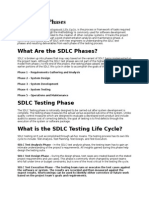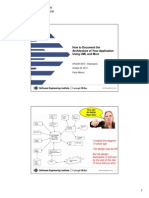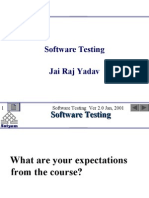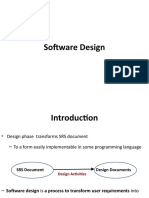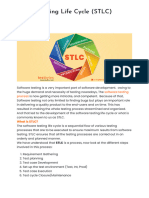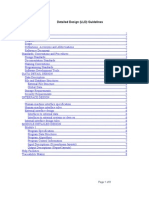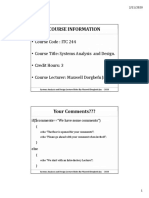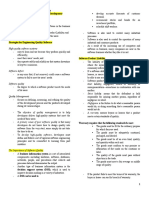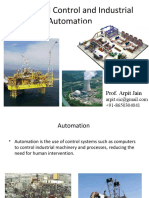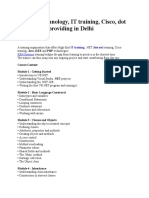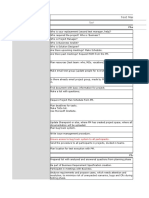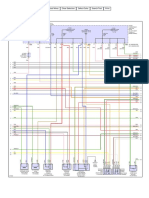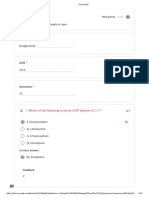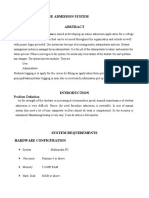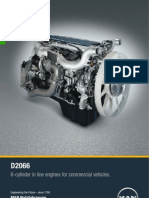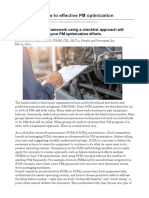Software Processes
October 2009
Ian Sommerville
�Objectives
To introduce software process models
To describe three generic process models and
when they may be used
To describe outline process models for
requirements engineering, software
development, testing and evolution
To explain the Rational Unified Process model
To introduce CASE technology to support
software process activities
October 2009
Ian Sommerville
�The software process
A structured set of activities required to develop a
software system
1.
2.
3.
4.
Specification;
Design;
Validation;
Evolution.
A software process model is an abstract representation of a
process. It presents a description of a process from some
particular perspective.
October 2009
Ian Sommerville
�Generic software process models
The waterfall model
Separate and distinct phases of specification and development.
Evolutionary development
Specification, development and validation are interleaved.
Component-based software engineering
The system is assembled from existing components.
There are many variants of these models e.g. formal development
where a waterfall-like process is used but the specification is a formal
specification that is refined through several stages to an
implementable design.
October 2009
Ian Sommerville
�Waterfall model
Requir ements
definition
Sy stem and
software design
Implementa tion
and unit testing
Integration and
sy stem testing
Oper ationand
maintenance
October 2009
Ian Sommerville
�Waterfall model phases
1.
2.
3.
4.
5.
Requirements analysis and definition
System and software design
Implementation and unit testing
Integration and system testing
Operation and maintenance
The main drawback of the waterfall model is the
difficulty of accommodating change after the
process is underway. One phase has to be complete
before moving onto the next phase.
October 2009
Ian Sommerville
�Waterfall model problems
Inflexible partitioning of the project into distinct stages makes it
difficult to respond to changing customer requirements.
Therefore, this model is only appropriate when the
requirements are well-understood and changes will be fairly
limited during the design process.
Few business systems have stable requirements.
The waterfall model is mostly used for large systems engineering
projects where a system is developed at several sites.
October 2009
Ian Sommerville
�Evolutionary development
Exploratory development
Objective is to work with customers and to evolve a
final system from an initial outline specification.
Should start with well-understood requirements and
add new features as proposed by the customer.
Throw-away prototyping
Objective is to understand the system requirements.
Should start with poorly understood requirements to
clarify what is really needed.
October 2009
Ian Sommerville
�Evolutionary development
Concurr ent
acti vities
Specification
Outline
description
Development
Validation
October 2009
Ian Sommerville
Initial
version
Intermedia te
versions
Final
version
�Evolutionary development
Problems
Lack of process visibility;
Systems are often poorly structured;
Special skills (e.g. in languages for rapid
prototyping) may be required.
Applicability
For small or medium-size interactive systems;
For parts of large systems (e.g. the user interface);
For short-lifetime systems.
October 2009
Ian Sommerville
10
�Component-based software engineering
Based on systematic reuse where systems are
integrated from existing components or COTS
(Commercial-off-the-shelf) systems.
Process stages
Component analysis;
Requirements modification;
System design with reuse;
Development and integration.
This approach is becoming increasingly used
as component standards have emerged.
October 2009
Ian Sommerville
11
�Reuse-oriented development
Requirements
specification
Component
analy sis
Requirements
modification
Sy stem design
with reuse
Development
and integ ration
October 2009
Ian Sommerville
Sy stem
validation
12
�Process iteration
System requirements ALWAYS evolve in the
course of a project so process iteration where
earlier stages are reworked is always part of
the process for large systems.
Iteration can be applied to any of the generic
process models.
Two (related) approaches
Incremental delivery;
Spiral development.
October 2009
Ian Sommerville
13
�Incremental delivery
Rather than deliver the system as a single delivery, the
development and delivery is broken down into increments
with each increment delivering part of the required
functionality.
User requirements are prioritised and the highest priority
requirements are included in early increments.
Once the development of an increment is started, the
requirements are frozen though requirements for later
increments can continue to evolve.
October 2009
Ian Sommerville
14
�Incremental development
Define outline
requirements
Develop sy stem
increment
Assign requirements
to increments
Design sy stem
architectur e
Integrate
increment
Validate
increment
Validate
sy stem
Final
sy stem
Sy stem incomplete
October 2009
Ian Sommerville
15
�Incremental development advantages
Customer value can be delivered with each
increment so system functionality is available
earlier.
Early increments act as a prototype to help
elicit requirements for later increments.
Lower risk of overall project failure.
The highest priority system services tend to
receive the most testing.
October 2009
Ian Sommerville
16
�Extreme programming
An approach to development based on the
development and delivery of very small
increments of functionality.
Relies on constant code improvement, user
involvement in the development team and
pairwise programming.
Covered in Chapter 17
October 2009
Ian Sommerville
17
�Spiral development
Process is represented as a spiral rather than
as a sequence of activities with backtracking.
Each loop in the spiral represents a phase in
the process.
No fixed phases such as specification or design
- loops in the spiral are chosen depending on
what is required.
Risks are explicitly assessed and resolved
throughout the process.
October 2009
Ian Sommerville
18
�Spiral model of the software process
Deter mineobjecti
ves,
alterna tives and
constr aints
Evalua te alterna tives,
identify, resolv e risks
Risk
anal ysis
Risk
anal ysis
Risk
anal ysis
REVIEW
Requir ements plan
Life-cy cle plan
Plan ne xt phase
Prototype 2
Risk
anal ysis Prototype 1
Simulations, models , benchmar ks
Concept of
Oper ation
S/W
requir ements
Development
plan
Requir ement
validation
Integ ration
andtestplan
Design
V&V
Service
October 2009
Oper ational
pr oto ype
Prototype 3
Ian Sommerville
Product
design
Detailed
design
Code
Unit test
Acceptance
test
Integ ration
test
Develop , verify
next-level pr oduct
19
�Spiral model sectors
Objective setting
Risk assessment and reduction
Risks are assessed and activities put in place to reduce the key
risks.
Development and validation
Specific objectives for the phase are identified.
A development model for the system is chosen which can be
any of the generic models.
Planning
October 2009
The project is reviewed and the next phase of the spiral is
planned.
Ian Sommerville
20
�Process activities
1.
2.
3.
4.
Software specification
Software design and implementation
Software validation
Software evolution
October 2009
Ian Sommerville
22
�Software specification (1)
The process of establishing what services are
required and the constraints on the systems
operation and development.
Requirements engineering process
1.
2.
3.
4.
October 2009
Feasibility study;
Requirements elicitation and analysis;
Requirements specification;
Requirements validation.
Ian Sommerville
23
�The requirements engineering process
Feasibility
stud y
Requir ements
elicitation and
anal y sis
Requir ements
specification
Requir ements
validation
Feasibility
repor t
Sy stem
models
User and sy stem
requirements
Requir ements
document
October 2009
Ian Sommerville
24
�Software design and implementation (2)
The process of converting the system
specification into an executable system.
Software design
Design a software structure that realises the
specification;
Implementation
Translate this structure into an executable
program;
The activities of design and implementation
are closely related and may be inter-leaved.
October 2009
Ian Sommerville
25
�Design process activities
1.
2.
3.
4.
5.
6.
Architectural design
Abstract specification
Interface design
Component design
Data structure design
Algorithm design
October 2009
Ian Sommerville
26
�A general model of the design process
Chapter 2 Software Processes
27
�The software design process
Requirements
specification
Design activities
Architectural
design
Abstract
specification
Interface
design
Component
design
Data
structure
design
Algorithm
design
Sy stem
architecture
Software
specification
Interface
specification
Component
specification
Data
structure
specification
Algorithm
specification
Design products
October 2009
Ian Sommerville
28
�Structured methods
Systematic approaches to developing a
software design.
The design is usually documented as a set of
graphical models.
Possible models
October 2009
Object model;
Sequence model;
State transition model;
Structural model;
Data-flow model.
Ian Sommerville
29
�Programming and debugging
Translating a design into a program and
removing errors from that program.
Programming is a personal activity - there is
no generic programming process.
Programmers carry out some program testing
to discover faults in the program and remove
these faults in the debugging process.
October 2009
Ian Sommerville
30
�Software validation (3)
Verification and validation (V & V) is intended
to show that a system conforms to its
specification and meets the requirements of
the system customer.
Involves checking and review processes and
system testing.
System testing involves executing the system
with test cases that are derived from the
specification of the real data to be processed
by the system.
October 2009
Ian Sommerville
31
�The testing process
Component
testi ng
October 2009
System
testi ng
Ian Sommerville
A cceptance
testi ng
32
�Testing phases
Sy stem
integration
test plan
Acceptance
test plan
Service
October 2009
Acceptance
test
Detailed
design
Sy stem
design
Sy stem
specification
Requir ements
specification
Sub-sy stem
integ ration
test plan
Sy stem
integ ration test
Ian Sommerville
Module and
unit code
and test
Sub-sy stem
integ ration test
33
�Software evolution (4)
Software is inherently flexible and can change.
As requirements change through changing
business circumstances, the software that
supports the business must also evolve and
change.
Although there has been a demarcation
between development and evolution
(maintenance) this is increasingly irrelevant as
fewer and fewer systems are completely new.
October 2009
Ian Sommerville
34
�System evolution
Define sy stem
requirements
Assess existing
sy stems
Propose sy stem
changes
Existing
sy stems
October 2009
Modify
sy stems
New
sy stem
Ian Sommerville
35
�The Rational Unified Process
A modern process model derived from the
work on the UML and associated process.
Normally described from 3 perspectives
1. A dynamic perspective that shows phases over
time;
2. A static perspective that shows process
activities;
3. A proactive perspective that suggests good
practice.
October 2009
Ian Sommerville
36
�The Rational Unified Process
phase model
Phase iteration
Inception
October 2009
Elaboration
Construction
Ian Sommerville
Transition
37
�RUP phases
Inception
Establish the business case for the system.
Elaboration
Develop an understanding of the problem domain
and the system architecture.
Construction
System design, programming and testing.
Transition
Deploy the system in its operating environment.
October 2009
Ian Sommerville
38
�RUP good practice
Develop software iteratively
Manage requirements
Use component-based architectures
Visually model software
Verify software quality
Control changes to software
October 2009
Ian Sommerville
39
�Static workflows
Workflow
Description
Business modelling
The bu siness processes are modelled using bu siness use cases.
Requirements
Actors who interact with the system are identified and use cases are
developed to model the system requirements.
Analysis and design
A design model is created and documented using architectural
models, component models, object models and sequence mod els.
Implementation
The components in the system are implemented and structured into
implementation sub-systems. Automatic code generation from design
models helps accelerate this process.
Test
Testing is an iterative process that is carried out in conjunction with
implementation. System testing follows the completion of the
implementation.
Deployment
A product release is created, distributed to users and installed in their
workplace.
Configuration and
change management
This supporting workflow managed changes to the system (see
Chapter 29).
Project management
This supporting workflow manages the system development (see
Chapter 5).
Environment
This workflow is concerned with making appropriate software tools
available to the software development team.
October 2009
Ian Sommerville
40
�Computer-aided software engineering
Computer-aided software engineering (CASE) is software to
support software development and evolution processes.
Activity automation
Graphical editors for system model development;
Data dictionary to manage design entities;
Graphical UI builder for user interface construction;
Debuggers to support program fault finding;
Automated translators to generate new versions of a program.
October 2009
Ian Sommerville
41
�Case technology
Case technology has led to significant
improvements in the software process. However,
these are not the order of magnitude
improvements that were once predicted
Software engineering requires creative thought - this
is not readily automated;
Software engineering is a team activity and, for large
projects, much time is spent in team interactions.
CASE technology does not really support these.
October 2009
Ian Sommerville
42
�CASE classification
Classification helps us understand the different types of CASE
tools and their support for process activities.
Functional perspective
Tools are classified according to their specific function.
Process perspective
Tools are classified according to process activities that are
supported.
Integration perspective
Tools are classified according to their organisation into integrated
units.
October 2009
Ian Sommerville
43
�Key points
Requirements engineering is the process of developing a
software specification.
Design and implementation processes transform the
specification to an executable program.
Validation involves checking that the system meets to its
specification and user needs.
Evolution is concerned with modifying the system after it is in
use.
The Rational Unified Process is a generic process model that
separates activities from phases.
CASE technology supports software process activities.
October 2009
Ian Sommerville
44







